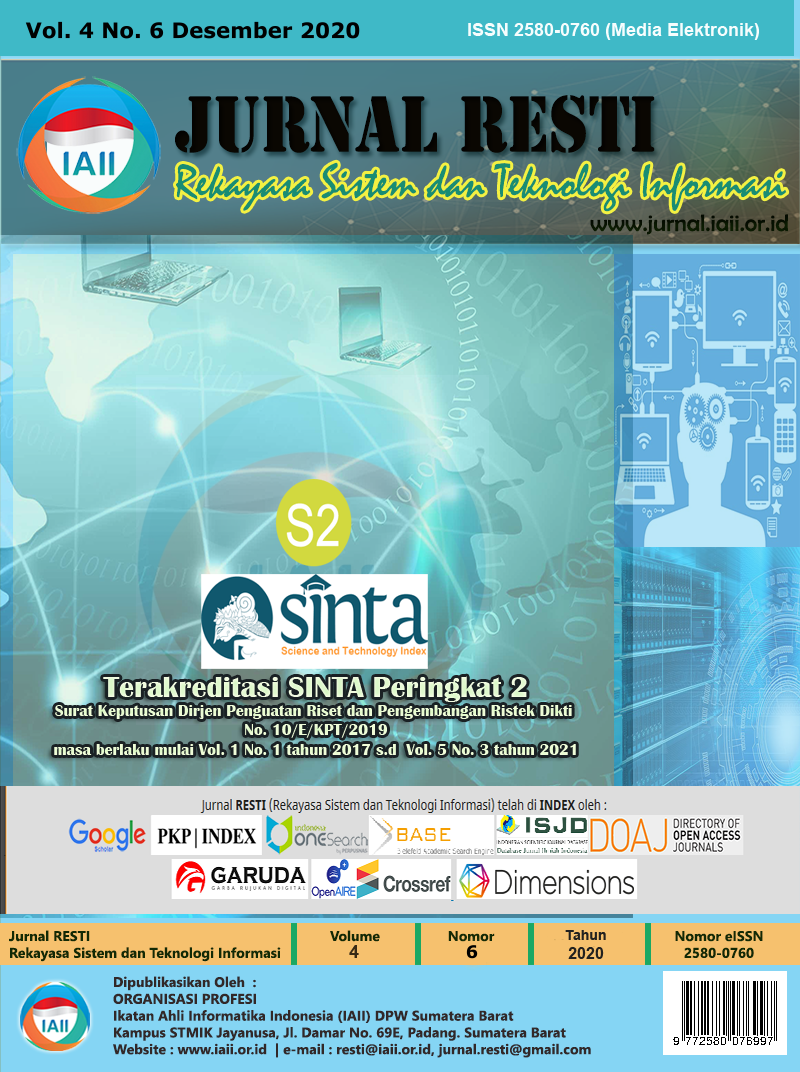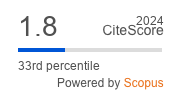EPDSAp: Aplikasi Skrining Baby Blues Berbasis Android dengan Uji Sensitivitas dan Spesifisitas
EPDSAp: Android-Based Baby Blues Screening Application with Sensitivity and Specificity Test
Abstract
Baby Blues Syndrome is depression that occurs in mothers within a few hours after giving birth, until a few days after delivery, and then it will disappear by itself if given good psychological care. One method to detect postpartum Baby Blues Syndrome is to use the EPDS (Edinburgh postnatal depression scale). However, currently, EPDS can only be done by health workers. Mothers cannot carry out their screening using this method. The purpose of this research is to produce an Android-based EPDS application that will be able to detect the symptoms of baby blues syndrome early after childbirth. Where the detection of the symptoms of baby blues syndrome can be carried out by postpartum mothers themselves quickly and easily, which in turn will reduce the negative impact of this syndrome. This study uses the System Development Life Cycle (SDLC) research method, where the stages of the activity plan are System / Information Engineering and Modeling, Software Requirements Analysis, Systems Analysis and Design, Code Generation, Testing, Implementation, and Maintenance. This EPDS application was built using Android Studio programming which can detect a postpartum mother experiencing the baby blues. This android-based EPDS design has a home screen form design, a questionnaire form design, and a result form design. This application displays results based on a score above 10, so the mother experiences depression or baby blues, while the score between 5 and 9 requires supervision of the mother and re-evaluation using the EPDS application.
Downloads
References
D. A. Fatmawati, “Faktor Risiko yang Berpengaruh Terhadap Kejadian Postpartum Blues,” J. EDU Heal., vol. 5, no. 2, pp. 83–93, 2015.
E. Hansotte, S. I. Payne, and S. M. Babich, “Positive postpartum depression screening practices and subsequent mental health treatment for low-income women in Western countries : a systematic literature review,” BioMed Cent., vol. 38, no. 3, pp. 1–17, 2017, doi: 10.1186/s40985-017-0050-y.
D. Sarli, I. Gunawan, and S. Poddar, “Early screening of baby blues based on Android applications : First-week postpartum ଝ,” Enfermería Clínica, vol. 30, no. 2019, pp. 129–132, 2020, doi: 10.1016/j.enfcli.2019.11.038.
D. Sarli and T. Ifayanti, “Baby Blues Screening on Post-Partum Mother by Comparing EPDS and PHQ-9 Methods For Health-Care Service And Public Applications in Lubuk Buaya Community Health Care Padang City , INDONESIA,” vol. 2, no. April, 2018.
J. Castle, “Early Detection of Postpartum Depression : Screening in the First Two to Three Days,” J. Lancaster Gen. Hosp., vol. 3, no. 4, pp. 147–150, 2015.
G. Palumbo, F. Mirabella, and A. Gigantesco, “Positive screening and risk factors for postpartum depression,” Eur. Psychiatry, vol. 42, pp. 77–85, 2017, doi: 10.1016/j.eurpsy.2016.11.009.
G. Bayu, E. Bhuana, A. P. Kharisma, and L. Fanani, “Rancang Bangun Prototipe Aplikasi Konsultasi Menu Makanan Berbasis Mobile Bagi Penderita Penyakit Diabetes Menggunakan Metode Harris,” J. Pengemb. Teknol. Inf. dan Ilmu Komput., vol. 3, no. 1, pp. 372–377, 2019.
E. Simamora, L. Ode, and A. Rahman, “Penggunaan M-Health Dalam Melakukan Implementasi Skrining Gejala Depresi Ibu Hamil Pada Kunjungan Antenatal Care (ANC),” J. Mitra Kesehat., vol. 2, no. 2, pp. 19–27, 2020.
S. Jiménez-Serrano, S. Tortajada, and J. M. García-Gómez, “A mobile health application to predict postpartum depression based on machine learning,” Telemed. e-Health, vol. 21, no. 7, pp. 567–574, 2015, doi: 10.1089/tmj.2014.0113.
M. O. H. Jasri and A. Buhari, “Rancang Bangun Kamus Kebidanan Berbasis Android Dengan Eclipse,” vol. 02, no. 01, pp. 39–44, 2016.
J. J. Dziak, D. L. Coffman, S. T. Lanza, R. Li, and L. S. Jermiin, “Sensitivity and specificity of information criteria,” Brief. Bioinform., vol. 00, no. January, pp. 1–13, 2019, doi: 10.1093/bib/bbz016.
S. D. Shrestha, R. Pradhan, T. D. Tran, R. C. Gualano, and J. R. W. Fisher, “Reliability and validity of the Edinburgh Postnatal Depression Scale (EPDS) for detecting perinatal common mental disorders (PCMDs) among women in low-and lower-middle-income countries: A systematic review,” BMC Pregnancy Childbirth, vol. 16, no. 1, 2016, doi: 10.1186/s12884-016-0859-2.
F. Rahmawati, “Gambaran ibu postpartum dengan Baby Blues,” J. Kesehat. Ibu adn Anak, vol. 1, no. 1, pp. 15–20, 2016.
K. A. Kaphingst, S. Persky, and C. Lachance, “Comparative Performance of Patient Health Questionnaire-9 and Edinburgh Postnatal Depression Scale for Screening Antepartum Depression,” vol. 14, no. 4, pp. 384–399, 2015, doi: 10.1080/10810730902873927.Testing.
T. I. Desi Sarli, Buku Ajar Skrining Baby Blues. Padang: Sinar Ultima Indah, 2017.
J. M. Schlittenhart, “Preparing Parents To Care For Their Nicu Infant: An Evidence Based: Discharge Teaching Tool,” Washington State University, 2011.
G. Roux, C. Anderson, and C. Roan, Postpartum Depression, Marital Dysfunction, and Infant Outcome: A Longitudinal Study, vol. 11, no. 4. 2002, pp. 25–36.
Copyright (c) 2020 Jurnal RESTI (Rekayasa Sistem dan Teknologi Informasi)

This work is licensed under a Creative Commons Attribution 4.0 International License.
Copyright in each article belongs to the author
- The author acknowledges that the RESTI Journal (System Engineering and Information Technology) is the first publisher to publish with a license Creative Commons Attribution 4.0 International License.
- Authors can enter writing separately, arrange the non-exclusive distribution of manuscripts that have been published in this journal into other versions (eg sent to the author's institutional repository, publication in a book, etc.), by acknowledging that the manuscript has been published for the first time in the RESTI (Rekayasa Sistem dan Teknologi Informasi) journal ;








